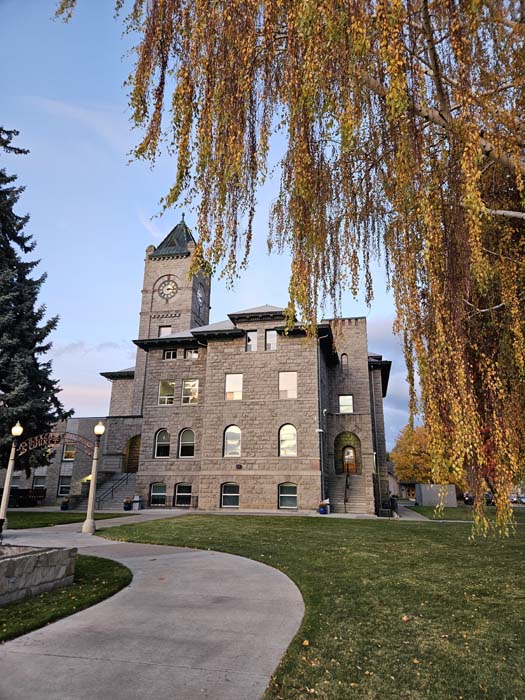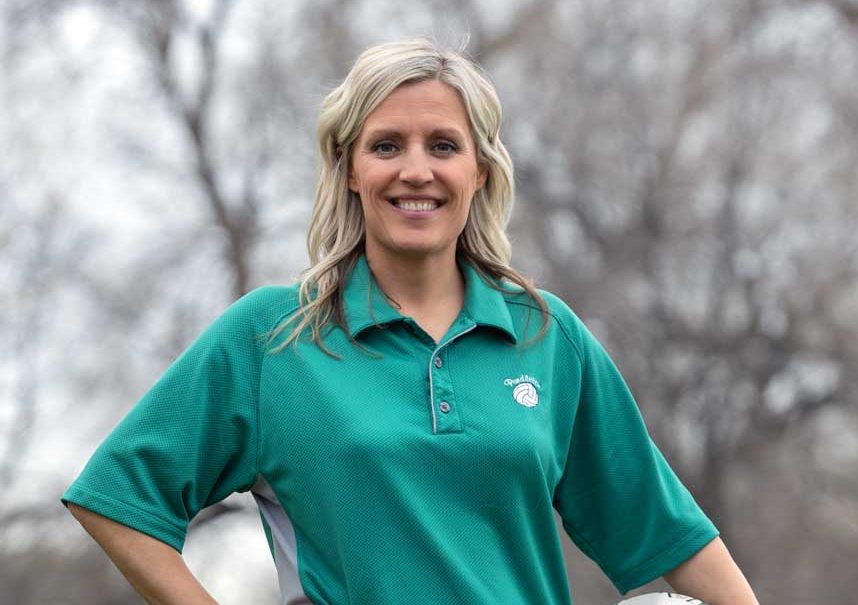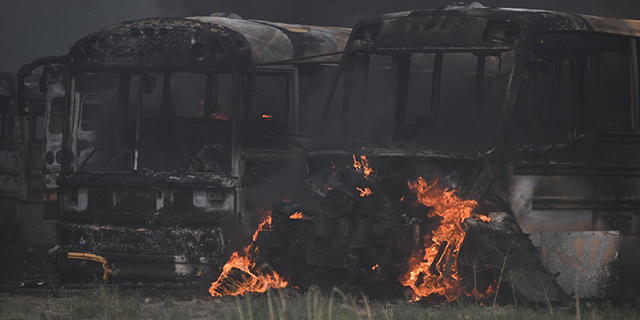Jury returns verdict
Published 12:20 am Friday, September 7, 2007
PENDLETON – A 12-person jury Thursday delivered a guilty verdict for second-degree assault to a Hermiston man involved in an April 26 brawl that sent an 18-year-old with stab wounds to Good Shepherd Medical Center.
But it also found him innocent of the more severe attempted murder charge.
The jury convicted Jose Edgar Salvad Cervantes, 23, of second-degree assault in a 10-2 vote but unanimously agreed he was innocent of attempted murder.
Circuit Court Judge Christopher Brauer acquitted Cervantes of a third charge, first-degree assault.
The jury’s verdict came around 9:30 p.m. Thursday in Courtroom No. 1, after three hours of deliberation and a day of testimony and argument that began at 9 a.m. The trial itself began at 1 p.m. the day before.
After the jury gave its verdict, Cervantes attorney, Dan Stephens, said he had a plan for the plea hearing, which is set for one week from today, on Sept. 14.
“We’re going to make an argument for probation,” Stephens said, “if the court finds it meets certain criteria.”
District Attorney Dean Gushwa said he couldn’t comment on the case until after sentencing. His Deputy District Attorney, Daniel Wendel, represented the state in the prosecution.
Throughout the day, the jury heard from law enforcement, medical personnel and witnesses of the fight at an apartment complex on Dogwood Avenue in Hermiston.
During that fight, Kevin Verwey, was stabbed in the abdomen and arms, according to Dr. Thomas Farney, who testified in the case.
The state accused Cervantes of causing the stab wounds in an attempt to kill Verwey, Stephens argued that Cervantes acted in self defense, and witness provided conflicting testimony.
Witnesses from the fight:
Devion Chalmers was one of the first witnesses on scene during the fight to testify.
He said he was driving in Hermiston on April 26 and picked up his cousin, Lawrence Morris. When Chalmers picked him up, Morris said he wanted to confront the man who had hit his car with a rock.
Also in the car, Chalmers said, was another friend and his daughter who is now seven months old.
Chalmers drove Morris to the apartment complex on Dogwood, where he and Morris got out of the car and talked to a man with the street name “Boxer” in the parking lot. Boxer’s actual name was never revealed in court.
Chalmers described the conversation as “calm,” but he believed Boxer was intoxicated.
“The guy was belligerent, you know what I’m saying?” He told the court.
While Morris and Boxer were talking, Chalmers said he saw Verwey driving by in a white Mustang. He said he and Verwey were friends and Chalmers flagged him down and asked him to watch what was going on.
“You never know what might happen from there,” Chalmers said. “It wasn’t like, get out and fight. Just watch.”
When Verwey arrived, Chalmers said Verwey climbed out of the mustang and Chalmers immediately jumped in between him and the group with Boxer, but after a time, stepped out of the way.
“All I remember from that point on is a fight,” Chalmers said. “I don’t remember who threw the first punch.”
Chalmers’ memory of the fight was sketchy.
He said Jordan Brown, a passenger in the Mustang, also got out of the car at some point.
“I never saw no knife,” he said. “I didn’t see the baseball bat. I didn’t see no weapons.”
Chalmers said the fight died down because everyone saw a child in the back of a pickup truck getting jostled around when someone tried to start up the truck. Chalmers said Cervantes went and grabbed the child, who was identified as his son, from the truck.
“Everybody was like, the kid! The kid!,” Chalmers said.
At that point, people made their way to leave. Verwey got back into his Mustang and Chalmers headed back to his vehicle.
Then, Chalmers said, “somebody said something and the fight started up again.”
“What happened to you?” Wendel asked.
“I wasn’t paying attention,” Chalmers said. “I turned around and they were fighting again.” He said he was concerned for his daughter’s safety and wanted to leave.
He didn’t remember what ended the fight and didn’t see Verwey get stabbed.
Junior Espain Covarrubias said he was friends with the men in the parking lot and had stopped to visit. He also said Boxer had been drinking and he saw Boxer throw a rock at a car. A short time late, he said Morris came and said he’d be back. Then he returned with Chalmers.
When asked if he saw a knife, Covarrubias said he didn’t. When asked if he saw a baseball bat, he said he did.
When Verwey arrived, Covarrubias said the Mustang pulled into the parking lot quickly.
“From my point of view it was reckless driving,” he said. “I knew right away he was going to start doing something.”
Covarrubias said he saw Verwey get out of his Mustang and pick up Cervantes.
“Like a wrestling move?” Stephens asked. In his opening arguments, Stephens had said Verwey was known as being a prominent high school wrestler.
“Yes,” Covarrubias said. “He landed flat on his back.”
After the initial fight broke up, Covarrubias said, “Kevin (Verwey) was already leaving, then he looked back at Jose (Cervantes) and told him, ‘What do you want me to do, beat your ass again?'”
He said Verwey used a wrestling move on Cervantes again.
“He just went to the ground,” he said.
Then Covarrubias said Brown come around the car with a small baseball bat, about two to two-and-a-half feet long. But he didn’t see Brown hit anyone with the bat.
After that, Covarrubias said he took Boxer, who was bleeding, to his home away from the apartment complex.
Brown said he didn’t see the fight start, but that it had by the time he got out of the Mustang after Verwey. He said he ended up fighting three other men when Chalmers came to his aid. He also said he saw Chalmers grab Cervantes’ son out of the pickup truck and the fight stopped.
He and Verwey got back in the Mustang and were on their way out when someone stood in front of the car.
“Kevin got out and they threw a punch at him,” Brown said. He pointed at Cervantes and said Cervantes threw the first punch.
Then Brown said he heard Verwey yell he’d been stabbed. At that point, Brown tried to grab the small baseball bat.
“I tried to get it but it was stuck under the seat,” he said.
Brown said he ended up wrapping his shirt around Verwey’s wounds and he and another passenger in the car took Verwey to Good Shepherd Hospital.
Law enforcement:
Two Hermiston Police officers and one detective testified, along with a detective and sergeant from the Las Vegas Metropolitan Police Department, who apprehended Cervantes in Las Vegas.
Officer William Golter said he was first to respond to the scene on Dogwood and he placed tape around the crime scene.
Officer Erica Sandoval first interviewed Verwey at Good Shepherd Medical Center and took photos of his wounds. Wendel showed those photos to the jury during opening and closing arguments.
She also collected blood samples found in the parking lot and on the sidewalk at the apartment complex, but the blood was never tested.
Detective Leonard Stokoe headed the investigation. During his testimony, he referred to his police report.
In the beginning of the investigation, Stokoe said it was difficult identifying people.
“There was a lot of ‘this guy’ and ‘that guy,'” Stokoe said. “No one knew who anyone was at the time.”
Stokoe, who also is a certified EMT, said a knife caused the three large wounds on Verwey’s abdomen and the smaller scratches on his face and neck.
However, Dr. Flaherty said earlier he described the wounds as medically superficial and only referred to those on Verwey’s chest and arms as inflicted by a knife.
Through his investigation, Stokoe said he tracked Cervantes to Las Vegas. Law enforcement there told Stokoe of Cervantes’ arrest on May 3, Stokoe said.
In reference to the blood samples Sandoval took, Wendel asked him why they had not been tested.
“To be honest, I don’t know,” he said. “I requested them to be analyzed but it never was analyzed.”
Verwey’s story:
Verwey said he was driving by the apartment complex when Chalmers flagged him down. He said he saw a large group of people arguing.
“They were toughening up,” he said, “getting ready for something to happen.”
He said he didn’t get out of the car immediately, but when he did he heard people yelling racial slurs and telling him he didn’t belong there. He also agreed, Chalmers stepped between him and the rest of the group. Then he heard more racial comments, Verwey said.
“Then it was like, I’m done,” he said. “I used a wrestling technique to take him up and get him on the ground.”
The “him” in this situation, Verwey said, was Cervantes’ brother, who Verwey referred to only by his street name “Lethal.”
Cervantes later testified that Verwey attacked him and not his brother.
Verwey said he pinned Lethal on the ground but then someone tried to kick him in the face and that Cervantes jumped on his back. Verwey said Brown took Cervantes off his back.
Then he stood up.
“It was over,” Verwey said. “It was done.”
He said he saw people scrambling as if police were on the way, so he and Brown headed for the Mustang.
“At that point someone stood in front of the car,” Verwey said. “The defendant started yelling into my window.”
Verwey got out of the car and said he saw Cervantes fishing in his pocket for something.
“He should have his hands out if he really wants to fight,” Verwey said.
He used another wrestling move on Cervantes and knocked him on the ground.
“I felt a couple sharp points,” he said, but paid no mind to them at first. Then he stood up, felt at his side and noticed the stab wounds. “I looked down and felt a wetness come off my side.
“I told Jordan (Brown), ‘He’s stabbed me, get the bat out of the car.'”
But Brown was unable to get the bat from the car.
Then he asked his friends to drive him to the hospital.
Cervantes’ story:
Cervantes said the afternoon began with him and his son eating an apple in the back of Cervantes’ pickup truck. They were sitting in the parking lot of the apartment complex.
Cervantes said he noticed Boxer was drunk and that he threw throw a rock at a car. He also said he saw Morris confront Boxer and then get Chalmers to confront him a second time.
“I was still in the back of my truck,” Cervantes said, “sitting in the bed with my son, eating an apple.”
Then he saw the Mustang pull up with Verwey inside. Though Cervantes said he didn’t know Verwey, he recognized him as a wrestler from seeing his photo in the newspaper.
“I hopped out and told the guy to leave,” Cervantes said. “I told him I didn’t want any trouble.”
Cervantes said Verwey told him he was there for Chalmers.
Then Verwey got out of the car and attacked him with a wrestling move. Cervantes said Verwey attacked him, not his brother.
“He grabbed my feet,” he said. “I hit the floor. … He picked me up and slammed me. … After that we separated.”
Cervantes described the fight as both grappling and throwing punches.
Then he heard Chalmers shouting about a danger to his son and Cervantes ran to grab his son off the truck. He passed the boy to his brother who took the child inside the apartment complex. He said he told Chalmers to leave.
Then he saw Verwey get into the Mustang. Cervantes said he went over and told Verwey to leave.
“Kevin looked at me,” he said, “and Devion told him to go at it. That’s when we fought again.”
Verwey used another wrestling move and pinned Cervantes to the ground, he said. Cervantes had difficulty describing how it was done, but said his legs were immobilized and Verwey put pressure on his chest.
“I just had my hands to move,” he said. “Suddenly I was looking up to the guy behind me with a little bat, a dark blue bat.”
He said the “guy” was Brown.
Cervantes said he was in fear for his life.
“I grabbed my pocket knife with my left hand and decided to defend myself,” he said. “I was almost out of air. He had my chest down.”
He said he thrashed out with the knife. When asked if Cervantes cut to kill, he said, “No.”
Then Verwey stood, said “you got me” and drove off.
Cervantes said he fled to Las Vegas, where his mother lives, because he was concerned for his safety and thought Verwey may come after him or his son.
“I knew he knew where I lived. I had no other choice but to take my son,” he said. “I had a fear for my son.”
When Wendel asked if Cervantes ran because of a possible warrant, Cervantes said no.
Closing arguments:
During closing arguments Stephens reminded the jury that the statements are arguments, not evidence.
Wendel argued that Cervantes started a second fight because his pride was hurt from being bested in front of his son, family and fiends. He said Cervantes called Verwey out with an intent to kill him.
Stephens re-affirmed his self-defense argument during his closing statements. He said Cervantes had no intent to kill but was only trying to defend himself and his son. Further, he said the state had not shown the burden of proof necessary for an attempted murder conviction.





